There are so many natural Easter egg dyes that you can use to color eggs without chemicals. Just turn to Mother Nature and the garden to source natural dyes that are inexpensive and easy to use.
Here are five recipes for how to dye Easter eggs naturally. These recipes are very easy to do and usually take just a few minutes to prepare. The most time is spent allowing the eggs to soak up the colors.
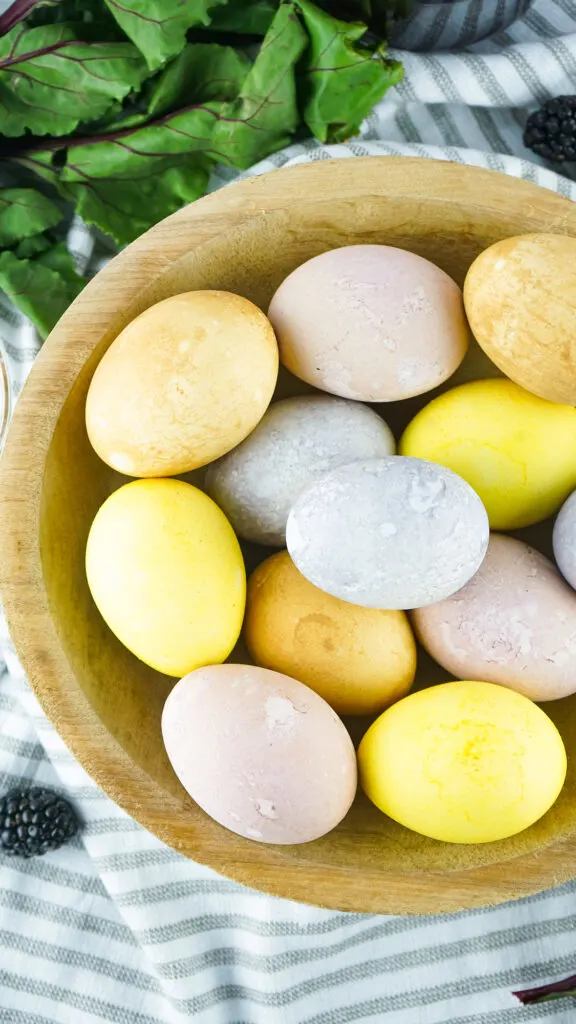
Nestle these eggs in a basket with these fun Easter grass alternatives for a more eco-friendly Easter basket. And be sure to include some of these fun organic Easter basket gifts or minimalist Easter basket gift ideas.
Helpful Tips for Using Natural Easter Egg Dye
- These dyes will stain everything they touch, just like food coloring dyes. So use caution with your materials. Let the eggs dry on a paper towel unless you want a cloth towel stained. When adding the dye to a bowl or pot, it may stain the items unless they are glass or stainless steel.
- Use white vinegar instead of apple cider vinegar. While you can use apple cider vinegar when dyeing eggs, that is not what I used in these recipes so I can’t predict if or how it might change the color of the dye. (Here’s the important differences of each type of vinegar.)
- Using more vinegar than called for could make the egg shells brittle and crack.
- These dyes were used on already hard boiled eggs. Some of the recipes do call for boiling the liquid for a long time, and you might try boiling the eggs in the simmering dye if you need to save time. However, I have not done this method and can’t recommend times to do it.
- In most of these natural dye recipes, the eggs soaked for 8 hours to achieve the colors. This could be a great project to do before bedtime and allow the eggs to soak overnight for deeper, darker shades of color.
- I used a dozen eggs for dyeing. You can probably dye even more eggs with the leftover liquid. Just be sure that there is enough liquid to completely cover the eggs, otherwise you will have white spots where the dye doesn’t cover. Each recipe makes 4-5 cups of dye.
- Consider using the leftover dye to color fabric such as cotton or linen for using in crafts.
- You can decorate the eggs before dyeing if you like. Consider using non-toxic beeswax crayons on the egg before coloring over it.
- If you have these produce and pantry ingredients on hand already, this can be a budget friendly Easter craft. (Here are some more cute Easter crafts.) It is great for using produce and plants that are overripe or for whatever reason will not be eaten.
- I won’t lie. If you are buying produce to make these Easter egg dyes, it might get expensive. You can buy a natural Easter egg dye kit with a variety of colors for less than the cost of buying the ingredients.
Dye Eggs with Beets
If you want naturally dyed pink Easter eggs, beets are the perfect way to get a pastel color. Even though beet juice looks so dark, it will actually dye the eggs a light shade of pink.
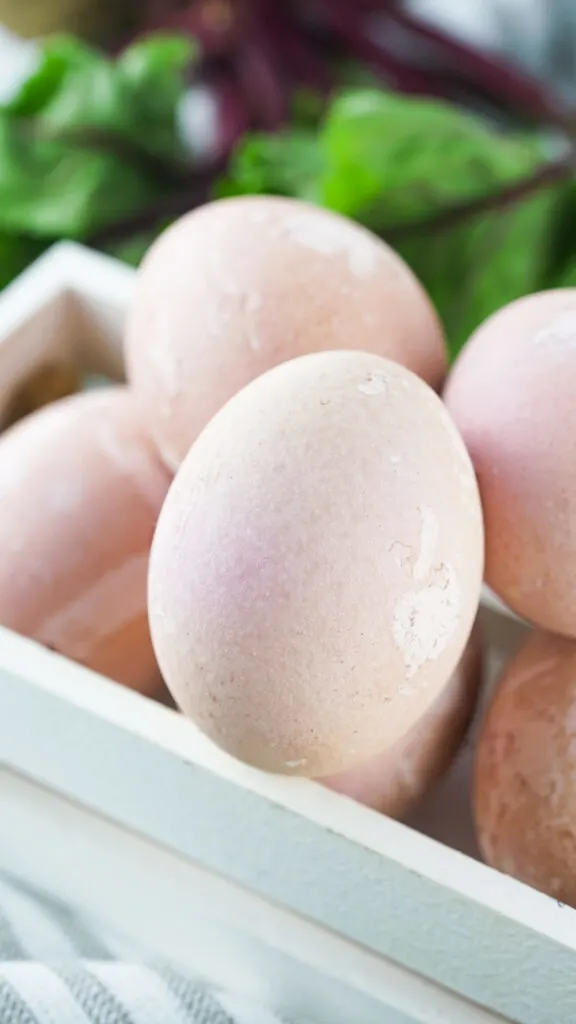
I’d say this pink color is more like a salmon or peachy-pink shade. It won’t be a neon pink like you would expect from an artificially colored Easter egg dye. For more tips, photos, and a printable how-to card, check out my DIY article of how to dye eggs with beets.
Ingredients
- 2 Large Beets, chopped into cubes
- 1 Cup White Vinegar
- 1 Quart (4 cups) Water
Directions
- Scrub the beets with a vegetable brush and trim off the ends before chopping them. If you do not, the color will turn out a brownish green which you don’t want! Slice the beets into thick slices, then cut into cubes.
- Bring the water to a boil in a large pot. Add the beets and let them simmer for around 30 minutes.
- Strain the liquid and pour into a heat-safe, glass bowl. Add in the vinegar and stir. The beet chunks can now be used in a recipe or added to your compost bin.
- Place the hard boiled eggs in the bowl of beet dye. Make sure they are completely covered.
- Keep the eggs in the dye until you get the color that you want. You can check them occasionally to see how the color is developing by gently lifting them out of the dye. For this color shown, the eggs soaked for about 8 hours.
- Foam will develop on top of the bowl of dye. You don’t need to remove it while dyeing the eggs. Once you are ready to remove the eggs, then you can remove the foam and take out the eggs.
- Once the color level has been achieved, remove the eggs from the dye using your fingers or tongs for eggs (I always use tongs like these when dyeing eggs) and place on a paper towel to dry. Flip the eggs over after a few minutes to prevent the dye from accumulating in one place where the egg is resting on the towel.
Dye Eggs with Turmeric
The vibrant yellow orange color of turmeric spice is a bold dye. If you want yellow eggs dyed naturally, this is your best choice!
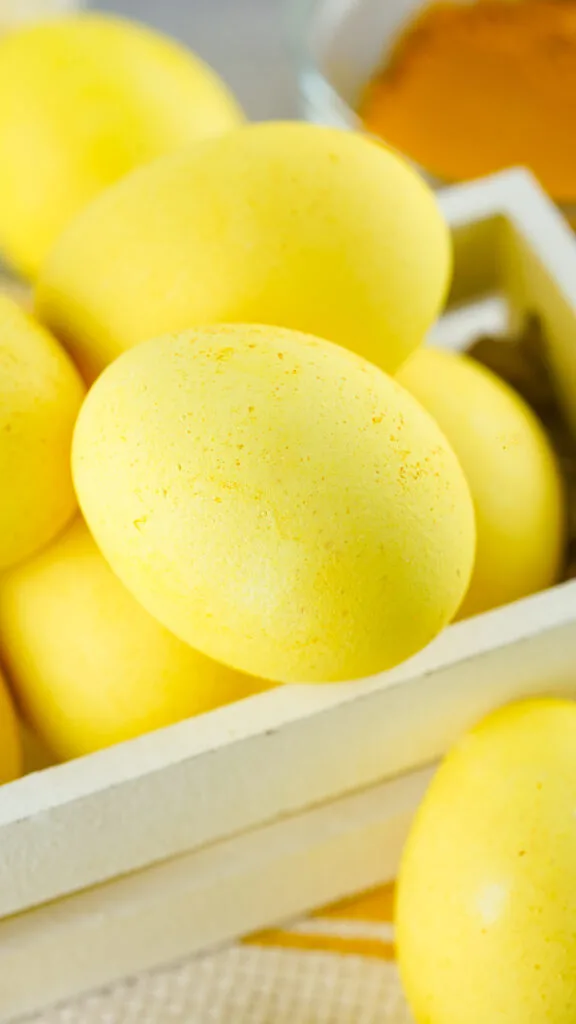
Turmeric is known for turning food dishes a warm shade of yellowish orange. Turmeric soap also has the same color.
For even more tips, photos and a printable how-to card, check out my DIY article on how to dye eggs with turmeric.
Ingredients
- 5 Tablespoons Turmeric (ground powder found in the spice aisle is fine)
- 1 Tablespoon White Vinegar
- 1 Quart (4 cups) Water
Directions
- Add the turmeric spice powder and the water to a pot. Bring to a boil, stirring frequently until the turmeric has dissolved. Remove from heat.
- Stir in the vinegar.
- Either leave the dye in your pot, or transfer it to a heat-safe, glass bowl.
- Add your hard boiled eggs into the turmeric dye. Don’t add too many at once because you need to eggs to be completely covered by the dye.
- Allow the eggs to soak until the yellow is a deep color. For ours, it took 8 hours to get this color of yellow.
- Once the color level has been achieved, remove the eggs from the dye using your fingers or tongs and place on a paper towel to dry. Flip the eggs over after a few minutes to prevent the dye from accumulating in one place where the egg is resting on the towel.
Dye Eggs with Blackberries
If you want a subtle, light blue color for your eggs, try dyeing with blackberries. This natural dye won’t give you a uniform look, so be prepared for that. What you will get is varying shades of blue and purple on the eggs, almost an ombre look.
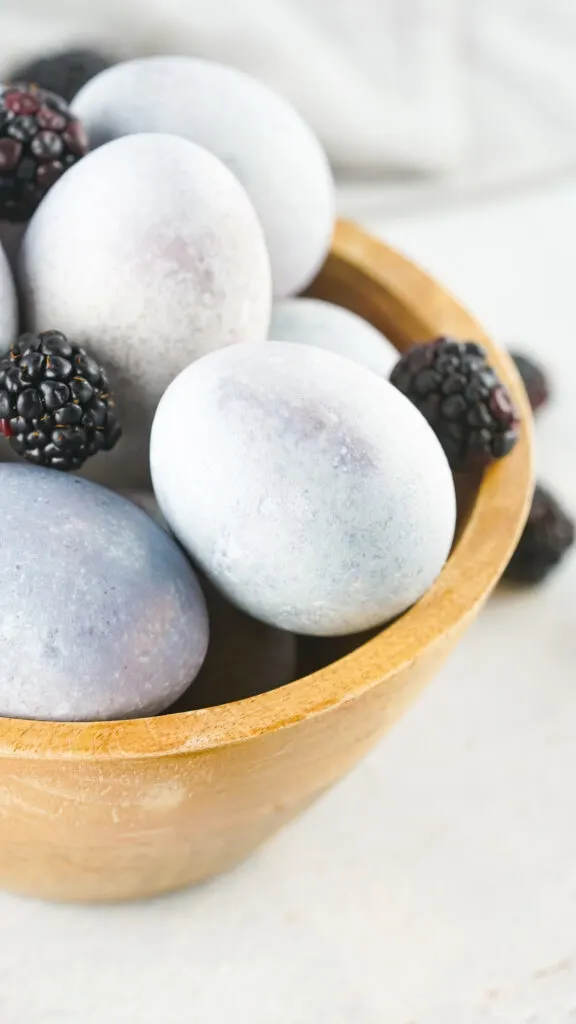
This is a great project if you have wild blackberries in your yard!
Ingredients
- 4 Cups Blackberries
- 1 Cup White Vinegar
- 1 Quart (4 cups) Water
Directions
- Place the water and blackberries in a pot and bring to a boil. Allow the berries to simmer in the boiling water for about 5 minutes. Then mash them with a spoon or a potato masher to break them up into tiny pieces.
- Stir the blackberry bits in the water so that they aren’t stuck to the pot. Then let simmer for another 5 minutes.
- Strain the mixture (cheesecloth is the best choice to get all of the little bits out) and put into a heat-safe, glass bowl. Add the vinegar to the bowl and stir.
- Place the eggs into the liquid dye and allow them to soak until you achieve the color that you want. Be sure they are completely covered. For this color, it took about 8 hours.
- Foam will develop on top of the dye. That’s okay! Don’t remove it until you are ready to remove the eggs from the bowl.
- Remove the eggs from the bowl with your fingers or tongs. Place on paper towels to dry. Flip the eggs over after a few minutes to prevent the dye from accumulating in one place where the egg is resting on the towel.
Dye Eggs with Tea
If you prefer a more neutral color palette, then you will love dyeing eggs with tea. This brown dye looks antiqued and is perfect for farmhouse decor.
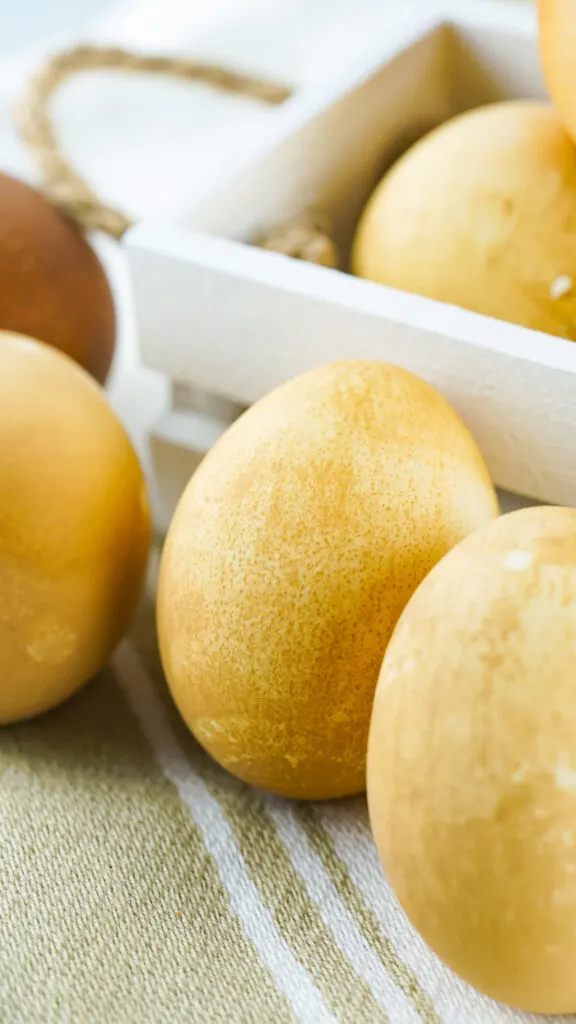
Black tea is very inexpensive to buy, which makes this natural Easter egg dye one of the most budget-friendly methods to use. For more helpful tips, in-process photos and a printable how-to card, visit my DIY tutorial of how to dye eggs with tea.
Ingredients
- 8 Black Tea Bags (individual cup size, not pitcher size)
- 1 Tablespoon White Vinegar
- 1 Quart (4 cups) Boiling Water
Directions
- Steep all of the tea bags in a heat-safe glass bowl with the boiling water. Keep the bags in the water for 10 minutes.
- Remove the tea bags from the bowl and squeeze out the liquid from each bag back into the bowl.
- Add the vinegar into the tea dye and mix together.
- Place the hard boiled eggs in the mixture and allow to soak until desired color is achieved. For this color, it took 8 hours.
- Remove the eggs from the bowl with your fingers or tongs. Place on paper towels to dry. Flip the eggs over after a few minutes to prevent the dye from accumulating in one place where the egg is resting on the towel.
Dye Eggs with Blueberries
Another great way to get blue colored eggs is to use blueberries. The process is very similar to dyeing eggs with blackberries, so choose the fruit that is least expensive or you have the most access to.
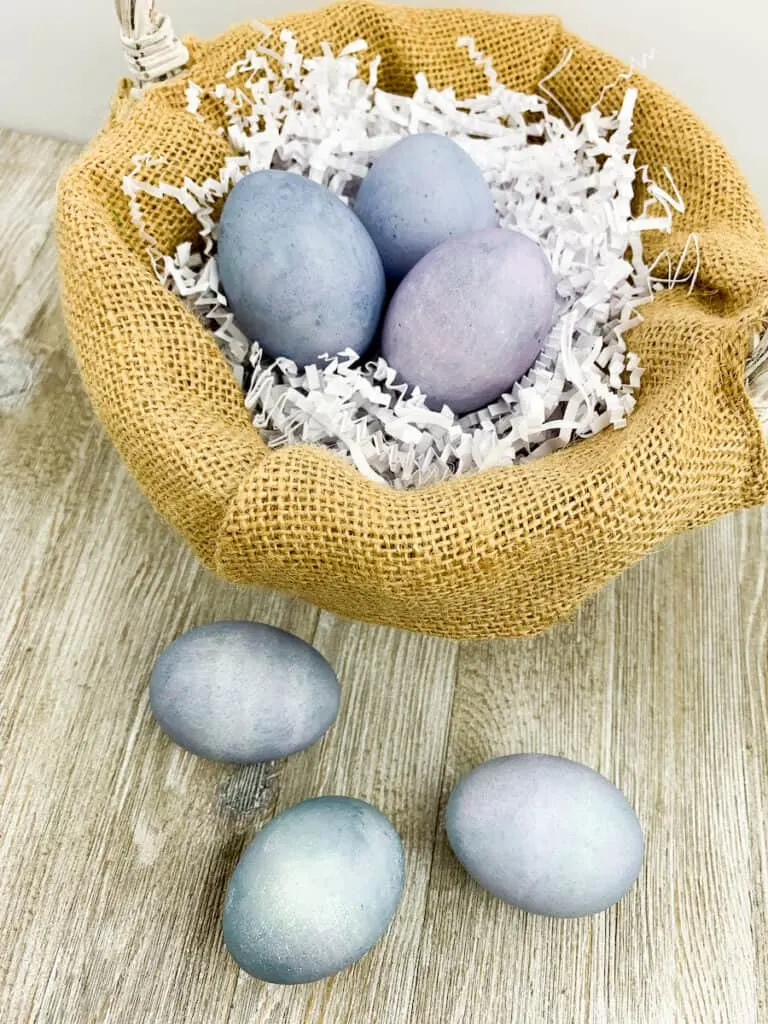
I made these Easter eggs at another time, so the amounts are different than the other ingredients. Keep in mind this recipe uses one-quarter the amount of water than the other recipes, so you will have one-fourth the amount of liquid dye.
I have found that blueberry dye is a bit darker than the blackberries. For the step-by-step photo instructions, see my recipe for how to dye Easter eggs with blueberries.
For even more natural Easter egg dyes recipes, download my free printable with recipes for seven different colors.